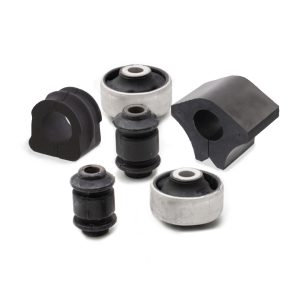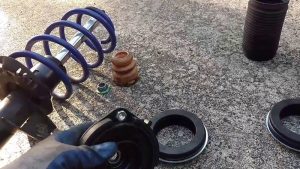Suspension systems are crucial for vehicle safety, comfort, and handling. While components like shocks, struts, and control arms often steal the spotlight, suspension bushings play a quieter — but equally essential — role. These small but mighty parts cushion the connection between metal components, absorb road shocks, and ensure smooth movement within the suspension system.
In this article, we’ll explore what suspension bushings are, the different types and materials, how they affect ride quality and performance, and when to replace them. Whether you’re a seasoned mechanic or a curious driver, understanding bushings helps keep your ride smooth and your car’s suspension in top condition.
What Are Suspension Bushings?

Suspension bushings are cylindrical linings made of rubber, polyurethane, or other materials, typically installed between metal parts of the suspension system. Their primary function is to reduce friction, absorb vibrations, and allow controlled movement of suspension parts like control arms, sway bars, and shock mounts.
Without bushings, metal-on-metal contact would result in increased noise, faster wear, and a harsh driving experience.
Why Suspension Bushings Matter
| Function | Impact on Vehicle |
|---|---|
| Absorb vibration | Reduces noise and cabin disturbance |
| Allow controlled movement | Improves steering feel and cornering stability |
| Reduce metal contact | Prevents wear and increases component life |
| Maintain alignment | Ensures proper geometry of suspension and tires |
| Transfer forces safely | Helps suspension parts react properly to road forces |
In short, bushings are essential for a quiet, safe, and smooth ride.
Common Suspension Bushings and Their Roles
| Bushing Type | Location | Function |
|---|---|---|
| Control Arm Bushings | Between control arm and frame | Allow up/down motion of suspension while staying aligned |
| Sway Bar Bushings | On sway/stabilizer bars | Reduce sway and roll while cornering |
| Shock Absorber Bushings | At mounting points of shock absorbers | Isolate road vibrations and shocks |
| Leaf Spring Bushings | In rear leaf spring suspensions | Cushion and center the springs |
| Subframe Bushings | Between body and subframe | Dampen engine and road vibrations |
Types of Suspension Bushing Materials
Different bushing materials offer various performance characteristics. Choosing the right material can impact handling, comfort, durability, and even noise levels.
1. Rubber Bushings
-
Most common material in factory setups
-
Great for absorbing vibrations and noise
-
Provide soft, comfortable ride
-
Tend to wear faster, especially under heavy loads or aggressive driving
Pros:
-
Excellent vibration damping
-
Quiet operation
-
Affordable
Cons:
-
Wear faster
-
Prone to cracking and deformation over time
2. Polyurethane (PU) Bushings
-
Popular in performance and aftermarket applications
-
Stiffer than rubber, offering improved handling and steering response
-
Resistant to oil, chemicals, and temperature changes
Pros:
-
Durable and long-lasting
-
Better performance handling
-
Less prone to deterioration
Cons:
-
Transmits more noise and vibration
-
May require lubrication to prevent squeaking
3. Solid/Metal Bushings (Performance Use)
-
Used in race cars or high-performance vehicles
-
Offer no cushioning, but deliver maximum rigidity and precision
-
Not suitable for daily driving due to harshness
Pros:
-
Ultimate performance feedback
-
Zero flex, precise alignment
Cons:
-
No comfort; not for street use
-
High wear on other suspension parts
Rubber vs. Polyurethane: Quick Comparison
| Feature | Rubber Bushings | Polyurethane Bushings |
|---|---|---|
| Ride Comfort | Excellent | Moderate |
| Handling Performance | Moderate | Excellent |
| Durability | Lower | High |
| Noise/Vibration | Minimal | Slightly higher |
| Maintenance | Low | May need greasing |
| Cost | Lower | Slightly higher |
Signs Your Suspension Bushings Need Replacement

Over time, bushings wear out, harden, or crack, leading to reduced suspension performance and other issues.
Common Symptoms of Worn Bushings:
-
Clunking or rattling noises, especially over bumps
-
Excessive body roll or sway
-
Poor steering response or instability
-
Uneven tire wear
-
Visible cracks, wear, or distortion
Regular inspections — especially every 10,000 to 20,000 kilometers — can help spot issues early.
When and Why to Upgrade Bushings
Replacing bushings with higher-quality materials is one of the most cost-effective suspension upgrades available.
Consider Upgrading If:
-
You drive aggressively or track your car
-
You’ve added other suspension modifications
-
You frequently tow or carry heavy loads
-
You want sharper steering and better cornering
Performance bushings (like polyurethane or hybrid designs) improve stability, response, and lifespan without replacing the entire suspension system.
Maintenance Tips for Longer Bushing Life
| Maintenance Task | Frequency |
|---|---|
| Inspect bushings for cracks | Every 10,000–15,000 km |
| Lubricate polyurethane bushings | Every oil change or 6 months |
| Wash undercarriage (especially winter) | After snow/salt exposure |
| Replace worn bushings early | At first signs of wear/noise |
Conclusion
Suspension bushings are small but essential components that impact how your car handles, feels, and performs. Whether rubber, polyurethane, or metal, each material offers distinct pros and cons. Worn or poor-quality bushings can lead to discomfort, reduced control, and accelerated wear of other suspension components.
Understanding bushing types, materials, and symptoms of wear can help you maintain optimal vehicle performance. And if you’re looking to upgrade or replace your bushings or rear suspension components, consider trusted suppliers where you can Buy Suspension online for a wide range of quality-tested products.
Keep your suspension solid, your handling tight, and your ride smooth — with the right bushings under your chassis.